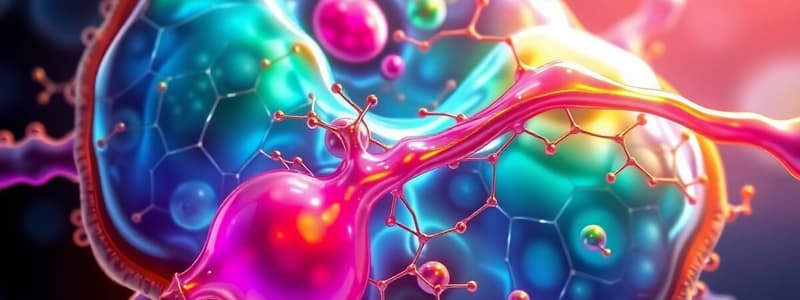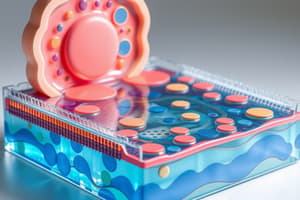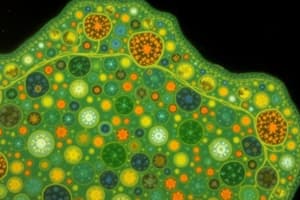Podcast
Questions and Answers
Which type of cell junction prevents substances from passing through the intercellular space between cells?
Which type of cell junction prevents substances from passing through the intercellular space between cells?
- Desmosomes
- Communicating Junctions
- Extracellular Matrix
- Occluding Junctions (correct)
The extracellular matrix is primarily composed of cellulose fibers.
The extracellular matrix is primarily composed of cellulose fibers.
False (B)
What is the main function of communicating junctions between cells?
What is the main function of communicating junctions between cells?
Facilitating communication and rapid transport of ions and micromolecules.
Desmosomes use proteins to connect cells, with an internal structure called plaques that include a ______ and protein.
Desmosomes use proteins to connect cells, with an internal structure called plaques that include a ______ and protein.
Match the following terms with their descriptions:
Match the following terms with their descriptions:
Why are smaller cells generally more efficient in substance exchange compared to larger cells?
Why are smaller cells generally more efficient in substance exchange compared to larger cells?
The fluid mosaic model of the cellular membrane consists of a single layer of phospholipids with proteins attached to one side.
The fluid mosaic model of the cellular membrane consists of a single layer of phospholipids with proteins attached to one side.
In the fluid mosaic model, which region of the phospholipid is attracted to water?
In the fluid mosaic model, which region of the phospholipid is attracted to water?
__________ proteins are located on one side of the cell membrane and interact with polar molecules.
__________ proteins are located on one side of the cell membrane and interact with polar molecules.
What is the primary function of carbohydrates on the outer surface of cell membranes?
What is the primary function of carbohydrates on the outer surface of cell membranes?
Match the prokaryotic structure with its function:
Match the prokaryotic structure with its function:
Which of the following structures is NOT a universal component of all prokaryotic cells?
Which of the following structures is NOT a universal component of all prokaryotic cells?
All membranes within a single cell have the same lipid and protein composition.
All membranes within a single cell have the same lipid and protein composition.
Which of the following structures found in eukaryotic cells is responsible for the synthesis of lipids?
Which of the following structures found in eukaryotic cells is responsible for the synthesis of lipids?
Mitochondria are inherited from both the mother and the father.
Mitochondria are inherited from both the mother and the father.
What is the main function of the nucleolus inside the nucleus of a eukaryotic cell?
What is the main function of the nucleolus inside the nucleus of a eukaryotic cell?
The internal membranes of the chloroplast, formed by flattened sacs containing chlorophyll, are called _.
The internal membranes of the chloroplast, formed by flattened sacs containing chlorophyll, are called _.
Match the following eukaryotic cell structures with their primary functions:
Match the following eukaryotic cell structures with their primary functions:
Which structure is responsible for cellular movement?
Which structure is responsible for cellular movement?
Plant cells contain centrioles for cellular division.
Plant cells contain centrioles for cellular division.
What is the role of mRNA in protein synthesis?
What is the role of mRNA in protein synthesis?
Which of the following is the primary function of the rough endoplasmic reticulum (RER)?
Which of the following is the primary function of the rough endoplasmic reticulum (RER)?
The Golgi apparatus primarily synthesizes proteins.
The Golgi apparatus primarily synthesizes proteins.
What is the main function of lysosomes?
What is the main function of lysosomes?
__________ are organelles containing enzymes that degrade toxic peroxides.
__________ are organelles containing enzymes that degrade toxic peroxides.
Match the cytoskeletal fibre with its primary function:
Match the cytoskeletal fibre with its primary function:
Vacuoles in plant cells perform which of the following functions?
Vacuoles in plant cells perform which of the following functions?
What is the primary difference between cilia and flagella in eukaryotic cells?
What is the primary difference between cilia and flagella in eukaryotic cells?
Which of the following best describes the role of motor proteins in conjunction with microtubules?
Which of the following best describes the role of motor proteins in conjunction with microtubules?
Flashcards
Fluid Mosaic Model
Fluid Mosaic Model
Basic structure of the cellular membrane; a double layer of phospholipids with proteins.
Hydrophilic Region
Hydrophilic Region
Region of a phospholipid attracted to polar molecules via water.
Hydrophobic Region
Hydrophobic Region
Region of a phospholipid made of nonpolar tails that repel water.
Integral Membrane Proteins
Integral Membrane Proteins
Signup and view all the flashcards
Peripheral Membrane Proteins
Peripheral Membrane Proteins
Signup and view all the flashcards
Prokaryote
Prokaryote
Signup and view all the flashcards
Nucleoid
Nucleoid
Signup and view all the flashcards
Cell Wall (Prokaryotic)
Cell Wall (Prokaryotic)
Signup and view all the flashcards
Desmosomes
Desmosomes
Signup and view all the flashcards
Occluding Junctions
Occluding Junctions
Signup and view all the flashcards
Communicating Junctions
Communicating Junctions
Signup and view all the flashcards
Cell Wall
Cell Wall
Signup and view all the flashcards
Extracellular Matrix
Extracellular Matrix
Signup and view all the flashcards
Chloroplasts
Chloroplasts
Signup and view all the flashcards
Cytoskeleton
Cytoskeleton
Signup and view all the flashcards
Pili
Pili
Signup and view all the flashcards
Nucleus
Nucleus
Signup and view all the flashcards
Ribosomes
Ribosomes
Signup and view all the flashcards
ATP (Adenosine Triphosphate)
ATP (Adenosine Triphosphate)
Signup and view all the flashcards
Mitochondria
Mitochondria
Signup and view all the flashcards
Endoplasmic Reticulum
Endoplasmic Reticulum
Signup and view all the flashcards
Rough Endoplasmic Reticulum (RER)
Rough Endoplasmic Reticulum (RER)
Signup and view all the flashcards
Smooth Endoplasmic Reticulum (REL)
Smooth Endoplasmic Reticulum (REL)
Signup and view all the flashcards
Golgi Apparatus
Golgi Apparatus
Signup and view all the flashcards
Lysosomes
Lysosomes
Signup and view all the flashcards
Peroxisomes
Peroxisomes
Signup and view all the flashcards
Vacuoles
Vacuoles
Signup and view all the flashcards
Cilia and Flagella
Cilia and Flagella
Signup and view all the flashcards
Study Notes
- Cells contain water, biomolecules necessary for survival, and approximately 10,000 types of diverse molecules.
- Cells can be minuscule or large, with diameters varying between 1 and 100 nm.
- The volume of a cell determines its functional level, with larger cells generally having higher activity.
- The surface area determines the amount of substances a cell can exchange with the external environment.
- The ratio between surface area and volume is adequate but not linear; when the volume increases, the surface area does not increase at the same rate.
- Small cells are more efficient because they have more surface area relative to their volume.
Cell Membrane - Fluid Mosaic Model
- The basic structure known as the fluid mosaic model is composed of a double layer of phospholipids with various proteins embedded within.
- Phospholipids
- They contain region that likes water (hydrophilic region) and region that do not (hydrophobic region).
- Hydrophilic region binds with polar molecules to water.
- Long, nonpolar hydrophobic regions interact with other nonpolar regions, do not dissolve in water, and do not bind to hydrophilic substances.
- In an aqueous environment, they arrange themselves into a bilayer with the hydrophobic tails facing inward and the hydrophilic heads facing outward, in contact with water.
- There are two types of membrane proteins:
- Integral proteins: They are embedded in the phospholipid bilayer and have both hydrophobic and hydrophilic parts.
- Peripheral proteins: They are located on only one side of the membrane and have neutral polar portions that interact with other polar molecules.
- Carbohydrates are present on the external surface for identification and adhesion between cells.
- Glycolipids
- Glycoproteins
- Lipids confer stability and fluidity to the membrane.
- Membranes can differ in composition even within the same cell, as they undergo chemical modifications when in contact with a specific organelle.
Prokaryotic Cells
- Includes archaea and bacteria.
- Possess a plasma membrane enclosing the cytoplasm (cytosol and insoluble particles).
- A specific region called the nucleoid contains the DNA and ribosomes where protein synthesis occurs.
- Some prokaryotes have specialized structures developed through evolution:
- Cell wall: Provides support and shape to the cell.
- Capsule: Preserves the cell and protects bacteria from attacks by the immune system.
- Internal membranes: Found in cyanobacteria to contain chloroplasts.
- Chloroplasts are plastids where photosynthesis takes place, varying in shape and size.
- They have two outer membranes, a circular DNA molecule, and internal membranes called grana formed by thylakoids, which contain chlorophyll and are suspended in a liquid called stroma (containing DNA and ribosomes).
- Cytoskeleton: Consisting of protein filaments, it is involved in cell division and maintaining the 3D structure of the cell.
- Flagella: Used for cell movement.
- Pili: Facilitate adhesion between bacteria or to animal cells.
Eukaryotic Cells
- Eukaryotic cells are found in fungi, animals, plants, and protists.
- Includes the plasma membrane and cytoplasm
- Nucleus: The nucleus houses DNA replication, enclosed by a nuclear envelope which is a double membrane separated by 10-20 nm.
- Nuclear envelope has approximately 3500 nuclear pores allow for the traffic of molecules, ions, and some proteins with short amino acid sequences for labeling.
- Nucleus contains various DNA molecules attached to proteins forming chromatin (which condenses into chromosomes) and the nucleolus (where ribosomes are assembled).
- Ribosomes: They contain ribosomal RNA (rRNA) and are assembled in the nucleolus.
- They then exit to synthesize proteins based on DNA information through translation, aided by messenger RNA (mRNA).
- Organelles: Internal compartments bounded by membranes contain enzymes.
- Different types of organelles include the Golgi apparatus (processes proteins), vacuoles (store water), mitochondria (energy centers), cytoskeleton (moves and supports the cell), rough endoplasmic reticulum (protein synthesis), and smooth endoplasmic reticulum (lipid synthesis).
- Nucleus: The nucleus houses DNA replication, enclosed by a nuclear envelope which is a double membrane separated by 10-20 nm.
- Animal Cell:
- centrioles (cell division)
- lysosomes (degradation of substance)
- Plant Cell:
- cell wall
- chloroplasts
Mitochondria
- Responsible for cellular respiration, which uses oxygen to break down nutrients and produce ATP (adenosine triphosphate), the main source of cellular energy.
- Each is composed of adenine, ribose, and three phosphate groups; its hydrolysis releases energy for cellular reactions.
- Consist of two membranes: an outer smooth protective membrane and an inner membrane folded into cristae, which regulate the passage of substances.
- The mitochondrial matrix houses enzymes, DNA (information to produce proteins necessary for respiration and various RNAs), and ribosomes.
- They are inherited from the mother.
Internal Membranes
- Endoplasmic Reticulum (ER): A network of interconnected internal membranes, with the internal space called the lumen.
- Rough ER (RER): Regions with ribosomes on the outer surface that synthesize and chemically modify proteins destined to leave the cell, such as secretory proteins.
- Smooth ER (SER): More tubular structures with activities due to enzymes in the membrane, synthesizing lipids, degrading toxic substances, drugs, and pesticides, hydrolyzing glycogen, and accumulating calcium ions (Ca2+).
- Golgi Apparatus: Discovered by Camillo Golgi, it receives and modifies proteins from the RER, labels them, and sorts them based on their destination.
- It also synthesizes polysaccharides for plant cells.
- It has three zones: the entry point (close to the nucleus and RER) where vesicles containing proteins enter, a transport zone through intermediate vesicles, and an exit point where substances are packaged for expulsion or integration into membranes.
Lysosomes
- Vesicles approximately 1 µm in size with a single membrane and digestive enzymes, formed in the ER and matured in the Golgi apparatus.
- Lysosomes degrade nutrients or foreign bodies taken in by the cell through phagocytosis, where the cell engulfs foreign particles, forming a food vacuole.
- This vacuole fuses with a primary lysosome to form a secondary lysosome, where digestion occurs; the products diffuse, providing necessary raw materials, and the residues are expelled.
- Lysosomes destroy harmful bacteria in white blood cells and perform autophagy, degrading old or damaged organelles for component recycling.
- Their structure includes compartments that isolate enzymes from the cytoplasm.
- Peroxisomes: Small granular organelles with enzymes that degrade toxic peroxides.
- Vacuoles: Cellular compartments filled with aqueous solutions, surrounded by a membrane.
- In plant cells, they store waste substances, regulate internal pressure to support the cell, contain pigments to attract pollinators, and release enzymes to digest nutrient reserves (accumulation, support, reproduction, digestion).
Cytoskeleton
- Formed by three types of fibers:
- Microfilaments: Polymers of the contractile protein actin, which maintain the cell's shape, are responsible for movement, and determine muscle contraction.
- Intermediate Filaments: Fibrous proteins organized into sturdy rope-like structures, which stabilize cell shape and help connect adjacent cells.
- Microtubules: Assembled from many molecules of the protein tubulin, determining the length; form a rigid internal skeleton and act as tracks for motor proteins, moving chromosomes during cell division.
Cilia and Flagella
- Mobile cell appendages consisting of microtubules: Cilia are numerous, while flagella are solitary or in pairs.
Cell Adhesion and Extracellular Structures
- The grouping of cells into tissues occurs through cell recognition, allowing cells to bind only to those of the same type, and cell adhesion, reinforcing connections. These processes depend on plasma membrane proteins and lead to the formation of structures that unite the cells, called cell junctions.
- Cell Junctions:
- Occluding junctions: Binding between specific proteins of the plasma membrane, sealing spaces between cells and preventing substances from penetrating between cells, also delimiting the parts of the membrane that have different functions.
- Communicating junctions: Protein channels crossing the plasma membranes of two adjacent cells, allowing communication and fast movement of ions and micromolecules from one cell to another.
- Desmosomes: Connect the plasma membranes of two adjacent cells, binding them through adhesion proteins that cross the membrane.
- They allow the passage of substances through the intercellular space and provide great resistance.
- Inside, there is a dense structure called a plaque, which binds to adhesion proteins that protrude outwards to connect with those of the adjacent cell in the intercellular space.
Additional Information of Cells
- Cell Wall: A semi-rigid structure composed of fibers of cellulose immersed in proteins and complex polysaccharides.
- The cell wall traversed by channels called plasmodesmata that connect it to adjacent cells, supports plant cells, protects them from infections, and maintains the shape of the plant.
- Extracellular Matrix: Composed of fibrous proteins (collagen) and a matrix of glycoproteins + proteoglycans (gelatinous/polysaccharide chains) + proteins, it holds cells together, supports tissue function, filters materials between tissues, keeps the cells of a tissue united, guides cell movements during development and regeneration, and facilitates communication between cells.
Studying That Suits You
Use AI to generate personalized quizzes and flashcards to suit your learning preferences.




